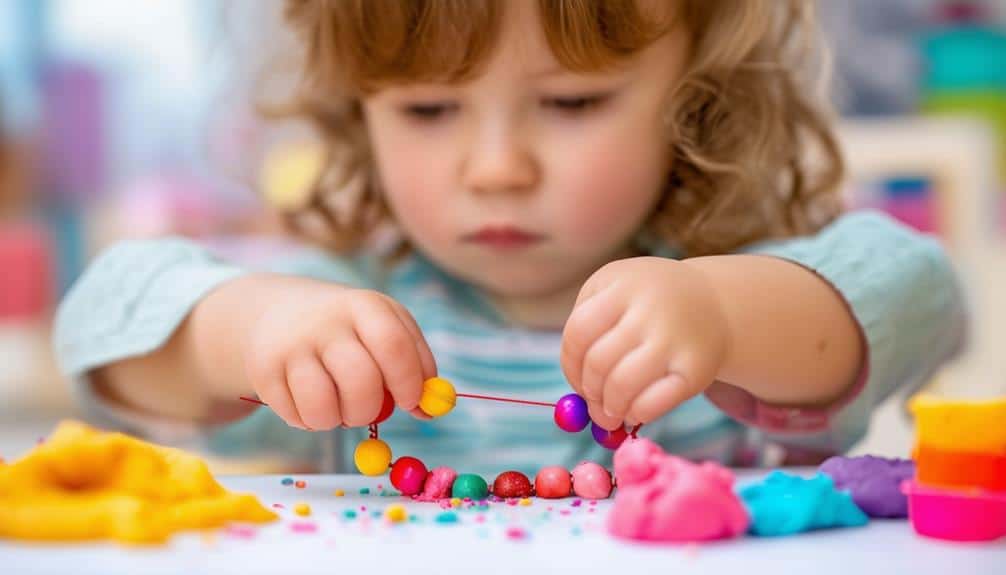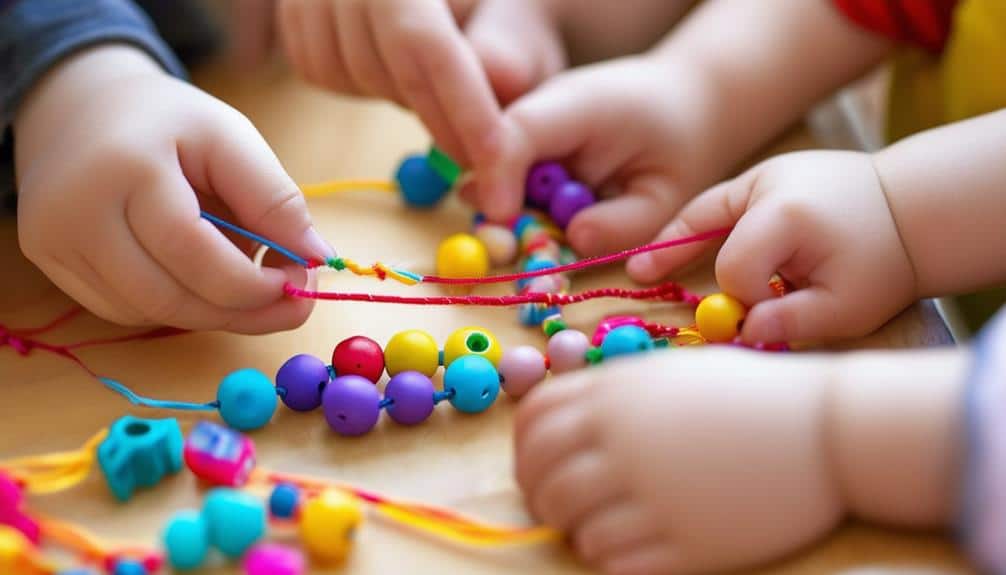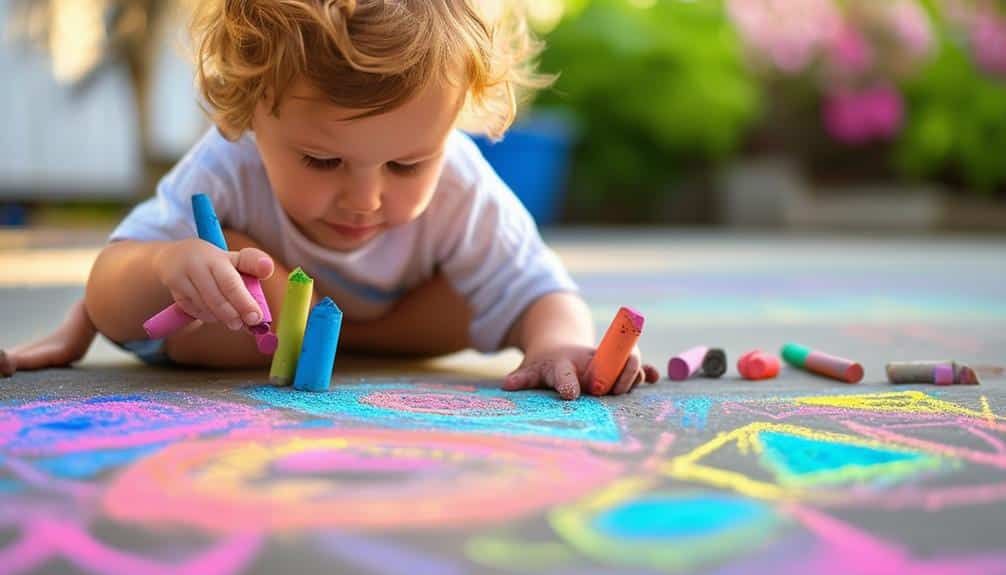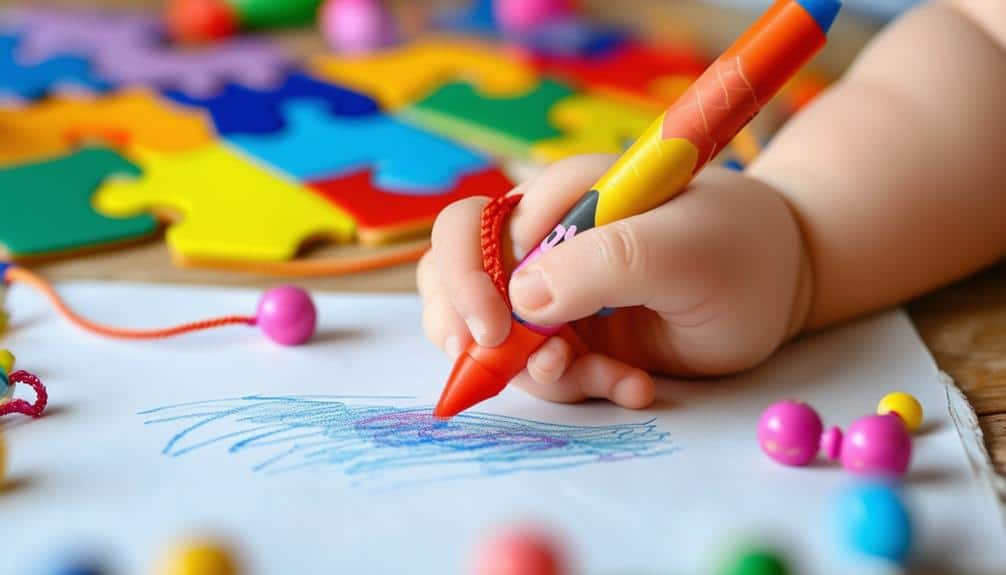Key Takeaways
- Engage children in crafting activities such as cutting, pasting, and coloring to boost their acceptable motor strength and precision.
- Encourage participation in daily chores like setting the table or folding laundry to refine hand-eye coordination and hand muscles.
- Foster hand-eye coordination in infants and toddlers through activities like stacking blocks, rolling balls, and sensory play.
- Utilize sticker, stringing, and paper activities to develop pincer grasp, visual motor coordination, and finger dexterity.
- To enhance fine motor control, introduce activities involving intricate hand movements, such as playing musical instruments or using tweezers.
Importance of Fine Motor Skills
Fine motor skills are crucial in early childhood development. They are essential for daily activities such as writing, dressing, and using utensils, which require the coordination of small muscles in the hands and fingers. These skills are vital for self-help tasks like buttoning clothes and using scissors, laying the foundation for academic tasks like handwriting and drawing, and preparing the child for school readiness.
Moreover, developing these skills from an early age promotes independence and confidence, allowing the child to navigate their world easily. Activities that foster fine motor skill development profoundly impact the child’s overall child’s development.
These skills are also essential in creative expressions such as playing instruments, painting, and crafting, contributing to the child’s artistic and cognitive development. Hence, it becomes necessary for parents, educators, and caregivers to understand the importance of fine motor skills in a child’s life and to incorporate activities that enhance these skills in their daily routine. This understanding and practice will contribute significantly to the child’s holistic development and future academic success.
Home Activities for Skill Improvement
Playful learning methods can enhance children’s fine motor skills in the comfort of their homes. We will explore various strategies, such as engaging children in creative play, introducing them to skill-enhancing daily chores and using crafting activities for better coordination. These activities promote development and coordination and provide an enjoyable and interactive learning method.
Fine Motor Play Ideas
Engaging in home activities such as threading beads, buttoning garments, and playing with building blocks can prove immensely beneficial for bolstering developing fine motor skills in early childhood. These fine motor activities, specially designed for preschoolers, help enhance hand coordination and muscle strength. They also foster creativity while simultaneously strengthening little hands.
Arts and crafts projects involving cutting, drawing, and coloring can be other effective ways to develop hand coordination. Toys and games that promote finger dexterity, like puzzles and pegboards, can help strengthen hand muscles.
Here are some ideas in a categorized form:
| Activity | Materials | Skills Developed |
|---|---|---|
| Threading Beads | Beads, Strings | Hand-Eye Coordination |
| Buttoning Garments | Clothes with buttons | Finger Dexterity |
| Building Blocks | Blocks of various shapes and sizes | Hand Strength |
Additionally, incorporating activities that demand precise hand movements, such as tweezers or playing musical instruments, can be beneficial. Let’s not forget activities. Let’s squeeze playdough, use clothespins, and thread laces to develop hand and finger strength. It’s all about providing opportunities for children to practice and enhance their fine motor skills.
Skill-Enhancing Daily Chores
Harnessing the potential of everyday chores, such as setting the table or pouring drinks, offers an excellent avenue for children to refine their fine motor skills. Often overlooked as mundane or trivial, these activities provide valuable opportunities for children to practice and develop substantial hand and finger movements.
Engaging children in tasks like buttoning clothes, zipping jackets, or fastening shoes can significantly enhance their hand coordination and agility. These tasks require precise finger movements and provide excellent practice for developing fine motor skills.
Likewise, inviting children to assist with chores like folding laundry, hanging clothes, or sorting objects can also foster the development of fine motor skills. These activities require children to manipulate objects of various sizes and shapes, improving their hand-eye coordination and precision.
Involving children in meal preparation tasks, such as measuring ingredients or stirring, can strengthen the hand muscles necessary for fine motor control. Similarly, encouraging children to dress independently can foster their fine motor skill development, which requires intricate finger movements.
Incorporating these daily chores into children’s routines can allow children to develop their fine motor skills.
Crafting for Coordination
Incorporating crafting activities into a child’s daily routine can enhance the child’s fine motor skills and hand-eye coordination. Such activities, including cutting, pasting, and coloring, foster creativity and boost acceptable motor strength. The precision required in these tasks allows children to exercise finger dexterity, promoting sturdy grip and precise hand movements.
Parents are encouraged to introduce various crafting projects to their young ones. This could include making homemade playdough, stringing beads, or creating colorful collages. These tasks encourage fine motor skill development by requiring the child to manipulate small objects, improving their manual dexterity.
Infants and Toddlers: Early Development

The early development stage of infants and toddlers is vital for advancing fine motor skills. Exploring textures and shapes, encouraging hand movements, and proposing activities for hand-eye coordination offers practical methods for this development. Children can use these techniques to enhance their talent, improve their hand-eye coordination, and strengthen their hand muscles engagingly and effectively.
Exploring Textures and Shapes
Delving into textures and shapes gives infants and toddlers unique opportunities to enhance their fine motor skills, foster sensory exploration, and cultivate spatial awareness. By offering toys with varying textures and shapes, we encourage the development of their hand-eye coordination as they reach for, grasp, and transfer objects between hands.
Their world, full of exciting new sensory experiences, can be further enriched by engaging in activities that allow them to explore and manipulate different materials. This can be achieved by:
- We are introducing finger painting activities, enabling them to feel the smoothness or roughness of paint.
- It provides sensory play with materials such as rice or sand, each with a distinct texture.
- We engage them in activities like stacking blocks or rolling balls, enhancing their spatial recognition and coordination.
- They offer toys with diverse shapes, promoting their ability to distinguish and recognize different forms.
Supporting infants and toddlers in discovering textures and shapes bolsters their fine motor skills and serves as a foundation for a deeper understanding of the world around them. This practical, hands-on approach fosters early development while keeping the process enjoyable and fascinating for the child.
Encouraging Hand Movements
Emphasizing hand movements in early development stages, specifically between the ages of 3-6 months, is fundamental in cultivating fine motor skills in infants and toddlers. This period witnesses the beginning of reaching and grasping for objects, which are essential skills to build for future development.
Tummy time is an invaluable practice at this stage. It helps infants strengthen their neck and arm muscles, laying the foundation for more complex hand movements. Encourage regular tummy time sessions to ensure the child’s safety and comfort.
Stacking blocks or playing with shape-sorting significantly enhances toddlers’ hand movements. Such activities strengthen their hand muscles’ understanding of spatial relations and forms. However, remember to keep these activities fun and engaging, as the goal is to stimulate their interest and curiosity, not to force a learning process.
Providing textured toys for exploration helps infants and toddlers enhance their sensory awareness and fine motor skills. Simple activities like transferring objects between hands or playing with rattles can also be practical. Every experience counts in this early stage; thus, giving them various opportunities to move and explore will be beneficial.
Activities for Hand-Eye Coordination
Moving forward in our exploration of early development, let’s consider activities that significantly enhance hand-eye coordination in infants and toddlers. Hand-eye coordination is a critical skill that underpins many activities, from catching a ball to writing and drawing. It’s a foundational aspect of fine motor skills, which, when nurtured eIt’s, can pave the way for a child’s successful physical, academic, and social development.
Considerchild’sllowing activities, which are wonderfully engaging and beneficial for developing hand-eye coordination and fine motor skills:
- Encouraging reaching and grasping: Offer toys out of immediate reach to encourage infants to stretch and learn. This simple act strengthens hand-eye coordination.
- Sensory exploration with toys: Provide toys of various textures and shapes. This stimulates sensory development and promotes hand-eye coordination as the child explores different surfaces and forms.
- Finger painting and sensory play: Engage infants and toddlers in finger painting, rice, or sand play. These activities are fun and foster both creativity and coordination.
- Stacking and rolling activities: Offering opportunities for stacking blocks or rolling balls can notably enhance hand-eye coordination.
Kindergarten Children: Enhancing Skills
Focusing on kindergarten children, there are multiple effective tactics for enhancing their fine motor skills, such as practicing writing letters and numbers with pencils or crayons. This simple activity introduces literacy basics and helps your child build fine motor control in their fingers and hands.
Further techniques to help your child build fine motor skills include cutting with scissors and tying shoelaces. These tasks require precise hand movements, enhancing their fine motor skills. Playing musical instruments or tweezers can also significantly benefit finger strength.
Introducing computer or tablet activities involving a mouse or touchscreen can aid with hand-eye coordination, while games that involve catching or throwing objects can further support this coordination. Here is a summary of the techniques:
| Activity | Skills Enhanced |
|---|---|
| Writing letters and numbers | Hand control, fine motor skills |
| Cutting with scissors, tying shoelaces | Precise hand movements |
| Playing musical instruments, using tweezers | Finger strength |
| Computer or tablet activities | Hand-eye coordination |
| Catching or throwing games | Hand-eye coordination |
Benefits of Developing Fine Motor Skills

Harnessing the power of fine motor skills in early childhood yields benefits, ranging from improved hand-eye coordination necessary for intricate tasks such as writing and drawing to enhanced academic performance and self-esteem. By fortifying these skills at home, we provide children with the tools to succeed in their educational and private lives.
The development and strengthening of these muscles ensure that children are prepared for more advanced tasks, such as using a computer mouse or playing a musical instrument. Fine motor skills are the foundation for many school tasks and daily activities, and their mastery promotes independence and cognitive development.
Here are some compelling reasons to prioritize fine motor skills:
- *Fostering independence:* Children with strong fine motor skills can independently manage tasks such as buttoning their clothes or using utensils.
- *Boosting cognitive growth:* Developing these skills promotes problem-solving abilities and critical thinking.
- *Enhancing academic performance:* Mastery of fine motor skills often leads to increased self-esteem and better performance in school.
- *Building solid muscles:* Regularly practicing these skills at home helps children develop strong, versatile muscles necessary for intricate tasks.
Sticker Activities for Skill Development
Using sticker activities in early childhood education provides an engaging and effective method to enhance children’s pincer grasp, visual motor coordination, and overall OK motor development. Peeling and placing stickers can improve finger dexterity and hand muscle strength, which is essential in building fine motor skills.
For instance, encouraging children to place stickers within drawn open circles promotes precision and hand-eye coordination. It challenges them to accurately control their fingers and hands accurately, fostering their fine motor control and manipulation abilities. In addition, this activity can be adjusted according to the child’s skill level, using smaller circles or stickers for challenges.
Incorporating sticker activities into a child’s routine makes skill development fun and provides a stress-free environment for learning. Children are often more inclined to participate in activities they perceive as play, making sticker activities an ideal tool for educators and parents.
Stringing Activities for Coordination

Stringing activities, such as threading beads, enhance fine motor skills in early childhood. These exercises foster hand-eye coordination, bilateral coordination, and finger dexterity as children employ both hands to arrange objects on a string. Moreover, they contribute to cognitive development by promoting problem-solving and concentration skills.
Benefits of Stringing Activities
Stringing activities focus on enhancing hand-eye coordination, fine motor skills, and bilateral integration. They are an effective method for developing finger strength, talent, and precision grasp in early childhood. The intricate movement required to thread string through a bead or Cheerio promotes muscle memory and hand coordination, creating a solid foundation for future tasks that demand the same precision.
Here are some of the primary benefits of stringing activities:
- *Trains the mind and the hand to work together*: The child’s brain learns to guide the hand in precise movements, and the child develops hand-eye coordination.
- *Enhances dexterity and precision*: Fine motor skills are sharpened as the child learns to manipulate small objects precisely.
- *Strengthens finger muscles*: The repetitive action of threading helps build finger strength, preparing the child for writing and other manual tasks.
- *Promotes bilateral integration*: The child learns to use both hands together in a coordinated way, an essential skill for various everyday tasks.
Incorporating stringing activities into a child’s routine can significantly assist in developing fine motor skills and hand control, providing them with the tools they need for success in school and beyond.
Engaging Stringing Exercises
Playing stringing exercises, such as threading beads or Cheerios onto string, can be immensely advantageous for developing children’s hand-eye coordination and fine motor skills. These activities promote bilateral coordination, muscle memory, and hand strength.
Stringing exercises are practical and straightforward, requiring only a few materials: string, yarn, or shoelace and small objects that can be threaded, like beads, pasta, or cereal. Start by demonstrating the process to the child, guiding their hands if necessary. As the child becomes more comfortable, encourage independent threading.
These activities enhance fine motor skills and hand-eye coordination, promoting finger dexterity and precision in manipulating small objects. Sensory feedback from feeling the beads, cereal, and string can also support concentration and focus.
With regular practice, children will gain confidence in their abilities, progressively improving their fine motor skills and hand-eye coordination. Always supervise the activity to guarantee safety, particularly with more minor children who might be tempted to put the objects in their mouths. The benefits of these stringing exercises far surpass the minimal effort and materials required to conduct them.
Paper Activities for Muscle Strength
Engaging in paper activities such as ripping, crumpling, folding, cutting, or crafting fosters creativity in children and contributes significantly to developing and strengthening their hand muscles, thereby enhancing fine motor skills. These activities require complex hand movements that promote finger dexterity.
For instance, tearing paper into small pieces requires the child to use a pincer grasp, essential for tasks like writing. Folding paper, on the other hand, encourages bilateral coordination, as both hands are needed to do the task. These activities help develop the necessary strength and control for precision tasks.
Here are some paper activities that can be introduced to children to develop their hand muscles:
- Origami: This traditional Japanese art of paper folding is excellent for improving hand-eye coordination and concentration.
- Paper Mache: This involves soaking paper in glue and forming it into shapes, strengthening hand muscles.
- Collage Making: Cutting and pasting different shapes and sizes of paper improves fine motor control.
- Paper Quilling: This activity involves rolling thin paper strips, promoting finger skill and precision.
Coin Activities for Precision

Coin activities can hone fine motor skills in early childhood, especially in promoting precision. Tasks such as coin sorting help develop hand-eye coordination and enhance finger strength while inserting coins into a piggy bank, which improves manual dexterity. Gradually increasing the complexity of these activities can provide a fun, progressive challenge that fosters the development of these critical skills.
Coin Sorting Skills
Coin sorting tasks, characterized by their emphasis on precision, offer an effective method for children to hone their fine motor skills by manipulating small objects. These engaging tasks provide children with tactile learning experiences, strengthening the connection between hand movements and visual input. This hands-on approach can significantly improve a child’s hand-eye coordination and fine motor control.
By sorting coins by size or denomination, children can enhance their finger dexterity, an essential aspect of fine motor development. These activities also promote concentration and attention to detail, vital for a child’s academic progress and everyday tasks.
Moreover, coin-sorting activities help children:
- Develop their ability to differentiate and categorize objects
- Lay the foundation for more advanced cognitive skills
- Enhance their problem-solving capabilities
- Improve their patience and persistence
When incorporated into a child’s routine, these activities can encourage the development of fine motor skills and lay a strong foundation for future learning. As educators and caregivers, we must provide children with these opportunities to grow and learn. The rewards of such investment are truly immeasurable.
Enhancing Finger Strength
Coin activities, such as placing coins in a piggy bank or sorting and stacking them, can effectively develop finger power and acceptable motor accuracy in early childhood. These activities necessitate meticulous manipulation of small objects, enhancing fine motor skills and hand-eye coordination, which are essential for a child’s overall development.
Coin activities during playtime make children fun and boost their fine motor skills and dexterity development. Such activities foster the pincer grasp, an essential fine motor skill involving the thumb and index finger picking up small objects. This grasp is necessary for holding a pencil, using utensils, and buttoning clothes, among other daily tasks.
Encourage children to sort and stack coins according to size or value to elevate the challenge and further develop finger strength. This exercise strengthens the fingers and improves visual-motor coordination, as children must carefully observe and differentiate between various coins. With patience and consistent practice, these coin activities can notably enhance a child’s finger strength and fine motor skills, preparing them for more complex tasks in the Burchfield activity.
Building on the concept of coin activities, the piggy bank activity offers a unique opportunity to improve precision and coordination skills in young children while simultaneously promoting the development of fine motor skills. This activity engages children in a fun, educational task and enhances hand and finger strength.
The piggy bank activity is an interactive way to teach children about money and manage it while boosting their fine motor skills and hand-eye coordination. Encouraging children to handle and manipulate coins supports the development of essential fine motor skills. Sorting and stacking coins in a piggy bank brings a sense of achievement, fostering a positive attitude towards learning and skill development.
A few specific ways to use the piggy bank activity to enhance fine motor skills include:
- We encourage children to insert coins into the piggy bank slot, enhancing hand-eye coordination.
- They invite children to sort coins by size or value, refining their accuracy.
- They are allowing children to stack coins, which demands agility and coordination.
- We are incorporating a game of attempting to extract coins, which requires strength, accuracy, and coordination.
Children can naturally develop their fine motor skills through this activity while having fun.
Clothespin Activities for Creativity
Engaging in clothespin activities fosters creativity in early childhood and promotes fine motor skills. These activities enhance hand strength, precision grasp, and hand-eye coordination. Introducing these activities, children strengthen their skills and finger manipulation, essential to their growth and independence.
Clothespin activities can be as simple as attaching clothespins to board books or garments. This introduces a fun and interactive element to play and encourages the child to focus on the task at hand, improving their concentration and coordination skills.
Incorporating clothespin tasks into daily routines further supports children in becoming more confident in their abilities. For instance, asking a child to help hang laundry using clothespins can make them feel involved and significant while also honing their fine motor skills.
Furthermore, using clothespins in arts and crafts projects allows children to express creativity. They can paint the clothespins, create patterns and designs, or use them to construct three-dimensional art pieces. These activities stimulate their imagination and offer practical ways to enhance their fine motor skills.
Sidewalk Chalk Activities for Coordination

Shifting our attention to outdoor activities, sidewalk chalk games offer another engaging and enjoyable avenue for enhancing children’s coordination and fine motor skills. These activities serve a significant educational purpose, improving children’s Motor and Gross Motor skills by engaging them in drawing children’s movements outdoors. This develops the muscles in their hands and fingers, which are essential for writing, buttoning clothes, and using utensils.
Sidewalk chalk activities offer a myriad of benefits:
- Boosting creativity: Children are encouraged to use their imagination and create large-scale artworks.
- Improving hand-eye coordination: Focusing on drawing specific lines and shapes sharpens this skill.
- Building gross motor skills: The physical movement of drawing and walking around to create art promotes whole-body coordination.
- Enhancing spatial awareness and balance: Children learn to navigate the space around them as they create their designs.
Threading and Lacing Activities
While outdoor activities have their place, indoor tasks such as threading and lacing allow children to refine their fine motor skills and improve hand-eye coordination. Manipulating objects like beads, pasta, or shoelaces requires precision, enhancing finger dexterity, essential for fine motor development.
These activities help build strong hand muscles necessary for tasks like writing and drawing. By engaging in these tasks, children become more adept at controlling their hand movements, an essential skill for their academic and individual growth. Threading activities can be tailored to match each child’s developmental stage.
Children can start threading more considerable beachbeachildren’s gradualness to smaller ones, incrementally increasing the difficulty level. This helps fine-tune their motor skills, fosters a sense of achievement, and encourages them to face challenges.
Remember to keep these activities fun and engaging, incorporating various materials to maintain interest. To summarize, threading and lacing activities are invaluable in honing fine motor skills and should be part of every child’s early learning journey.
Putty Activities for Finger Strenght
child’s fine motor skill development and putty activities are effective methods to bolster finger strength, improve grip, and enhance agility in children. These activities foster the child’s hand strength and provide a fun and engaging way to develop the child’s motor skills. Squeezing and molding the putty stimulates the child’s tactile senses while targeting specific hand muscles and child coordination.
Engage children with putty activities by incorporating the following exercises:
- Flattening the Putty: Children can use the palms of their hands to flatten the putty on the table, which helps to build hand strength.
- Pinning and Pulling: Encourage children to pinch the putty with their fingers and then pull it apart. This promotes finger dexterity and strength.
- Rolling into Balls: Children can improve their finger coordination by rolling small pieces of putty into balls.
- Making Putty Snakes: Rolling putty into lengthy, thin snakes can enhance grip strength and fine motor skills.
Consistent practice with these putty activities will make writing and drawing easier and lay a solid foundation for the child’s overall motor skill development.
Pick Up Sticks Activity for Isolation
Have you considered the Pick Up Sticks game a tool to promote finger isolation and fine motor control in children? This engaging activity, involving picking up sticks one by one without disturbing the others, is a fun and practical method to enhance a child’s precision and coordination.
The Pick Up Sticks game is more than a child’s developmental tool that can significantly enhance fine motor skills. The use of different fingers for each stick aids in isolating finger movements, strengthening hand muscles, and promoting better finger coordination.
Moreover, it fosters hand-eye coordination and concentration skills, giving children a meaningful and enjoyable way to develop these essential abilities. In addition, this activity encourages children to develop patience and attention to detail, qualities that will benefit them far beyond the playground.
In a world where screen time is prevalent, the Pick Up Sticks game offers a hands-on, interactive experience that nurtures essential motor skills and cognitive development. It’s a valuable addition to any early childhood program, providing a distinctive practical approach to fostering fine motor control and finger coordination.
Frequently Asked Questions
How to Develop Fun Fine Motor Activities in Early Childhood?
Engage children in activities that require hand-eye coordination and precision to develop fine motor skills in early childhood. Threading beads, drawing, and independent dressing can enhance these skills while improving strength and agility.
How Can Teachers Help Children Develop Fine Motor Skills?
Teachers can foster fine motor skills development in children through activities requiring hand-eye coordination, such as puzzles or bead threading. Hands-on tasks like cutting, coloring, and block building also help enhance these skills.
What three activities can you implement to support learners’ fine motor development?
Three practical activities for enhancing fine motor skills include threading beads, which improves agility, using scissors to cultivate hand-eye coordination, and squeezing playdough to strengthen hand muscles.
What strategies would you implement to help support fine motor skill development in infancy?
To foster fine motor skill development during infancy, implement strategies such as introducing textured toys for tactile exploration, promoting activities that enhance hand-eye coordination, and encouraging sensory play with materials like sand or rice.
Conclusion
Developing fine motor skills during early childhood lays the foundation for essential life skills. Engage your child in fun activities like threading beads, finger painting, and cutting with child-safe scissors. These simple activities strengthen their finger muscles and boost their confidence in handling more complex tasks. Incorporate motor practice into daily routines with games like threading a colored pipe cleaner through a piece of paper or using kitchen tongs to pick up small items, turning everyday tasks into hands-on adventures.
Please encourage your child’s artistic expression by introducing them to tools like colored pencils and construction paper. Let them experiment with scissor skills or enjoy a playdough sculpting contest to improve motor control and bilateral coordination. You can also use an ice cube tray for sorting or a cookie sheet for building simple shapes with foam sheets, making learning fun and effective. These activities help preschoolers and toddlers achieve motor milestones while having a great time.
Finally, remember that incorporating motor skills activities into your child’s routine is vital to their motor development. With fun games, crafts, and everyday activities, your child will develop strong motor skills and a sense of achievement. These activities support their growth and add excitement to their everyday lives.


Recent Comments